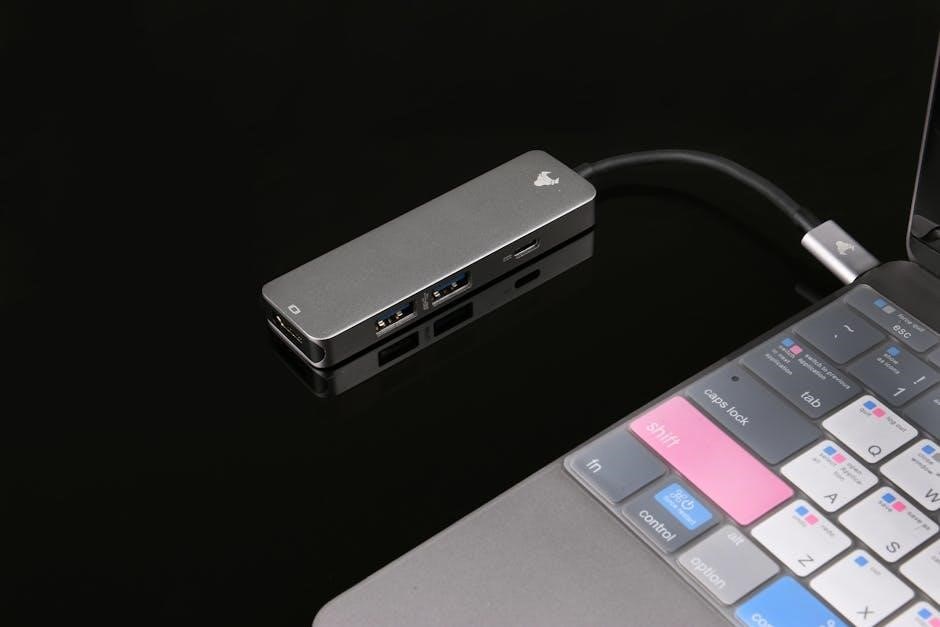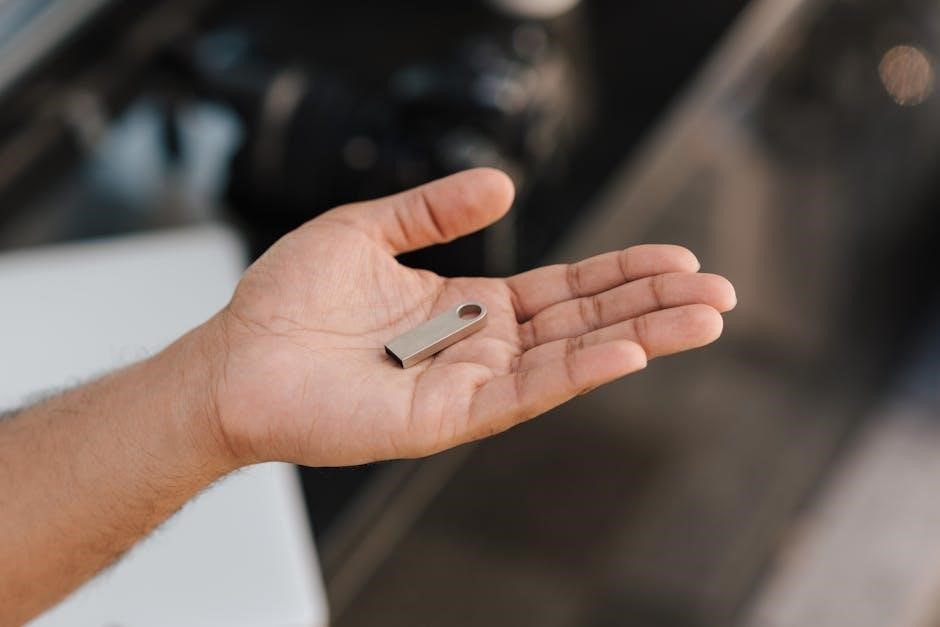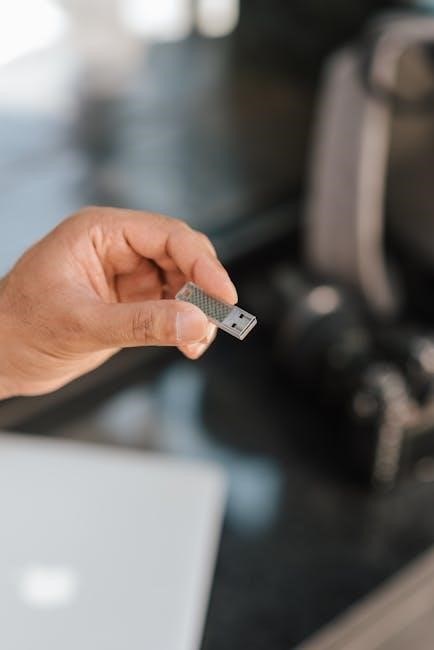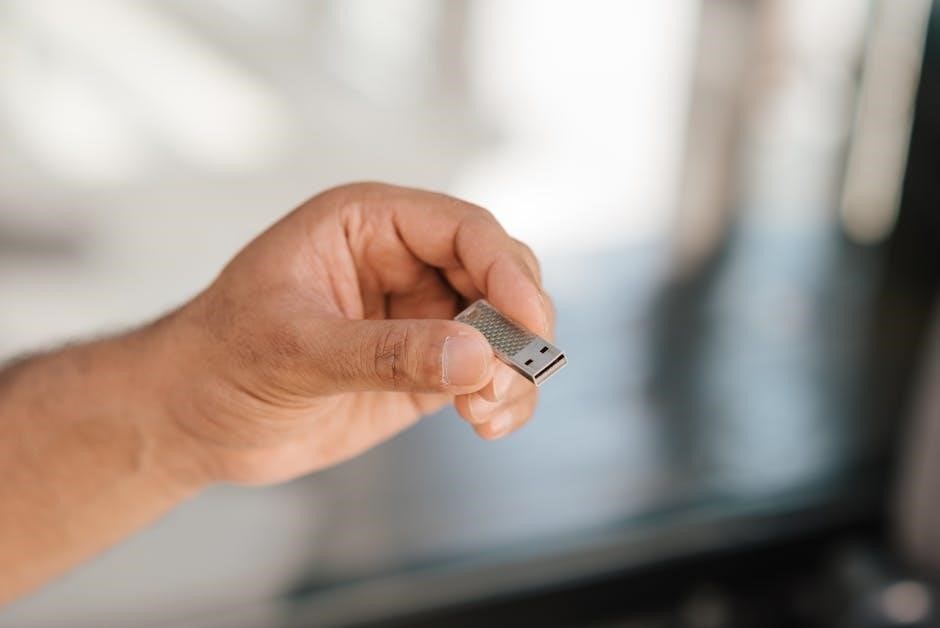A USB hub expands a single USB port into multiple ports, enabling connection of several devices. It enhances data transfer efficiency, supporting various devices like drives and peripherals.

Factors Affecting Data Transfer Speeds
Data transfer speeds are influenced by USB standards, cable quality, port configuration, and device capabilities. USB 3.0 and 3.1 offer faster rates than USB 2.0, while cable length and power delivery also impact performance.
USB Standards and Versions
USB standards and versions significantly impact data transfer speeds. USB 2.0 offers up to 480 Mbps, while USB 3.0 increases this to 5 Gbps, and USB 3.1 further boosts it to 10 Gbps. USB-C, part of the USB 3.2 standard, supports up to 20 Gbps, making it ideal for high-bandwidth devices. Newer versions like USB 4.0 and Thunderbolt integrate even faster speeds, reaching up to 40 Gbps. The compatibility of devices with these standards ensures optimal performance. Always choose a USB hub that matches your device’s highest supported USB version for the best data transfer experience. Upgrading to newer USB versions future-proofs your setup and enhances efficiency.USB standards and versions are foundational to achieving faster and more reliable data transfers.USB standards and versions are foundational to achieving faster and more reliable data transfers.
Port Configuration and Types
Port configuration and types play a crucial role in determining data transfer efficiency. USB hubs come with varying port types, such as USB-A, USB-B, and USB-C, each catering to specific devices. Standard ports like USB 3.0 and USB 2.0 are common, while USB-C offers reversible connectivity and higher speeds. Some hubs feature a mix of port types to accommodate legacy and modern devices. Port configuration can also impact bandwidth allocation, as shared bandwidth models may slow down data transfer when multiple devices are connected. Dual-layer or multi-layer hubs often provide dedicated channels for high-speed devices. Choosing a hub with the right port configuration ensures optimal performance for your specific needs. Always consider the port types and their compatibility with your devices to maximize data transfer efficiency.USB standards and versions are foundational to achieving faster and more reliable data transfers.
Cable Quality and Length
Cable quality and length significantly impact data transfer speeds. High-quality USB cables with proper shielding minimize signal interference and ensure stable connections. Longer cables can degrade signal integrity, leading to slower data transfer rates. USB specifications recommend maximum cable lengths to maintain reliability—typically up to 3 meters for USB 2.0 and 3 meters for USB 3.0. Exceeding these lengths may result in reduced performance or connectivity issues. Additionally, the thickness and material of the cable affect power delivery and data transmission efficiency. Always opt for shorter, high-quality cables to optimize data transfer speeds and ensure reliable connections. Poor-quality or damaged cables can introduce bottlenecks, negating the benefits of faster USB standards. Prioritizing premium cables ensures optimal performance for your USB hub and connected devices.
Best Practices for Optimizing Data Transfer
Connect high-bandwidth devices directly to your computer to avoid shared bandwidth limitations. Use powered USB hubs for external drives to ensure sufficient power delivery and stable connections. Prioritize devices based on speed requirements to maximize efficiency and minimize bottlenecks during data transfer.
Connecting High-Bandwidth Devices Directly
Connecting high-bandwidth devices directly to your computer ensures optimal data transfer speeds and minimizes potential bottlenecks. USB hubs can share bandwidth among connected devices, which may reduce performance for high-speed peripherals like external hard drives or SSDs. Direct connections eliminate this issue, allowing devices to operate at their maximum capabilities. For example, USB 3.0 or 3.1 devices can achieve speeds up to 5 Gbps when connected directly, while a hub might limit this performance. Prioritizing direct connections for devices requiring high-speed data transfer, such as video equipment or large storage solutions, is a best practice. This approach ensures reliable and efficient data transfer, leveraging the full potential of your hardware.
Using Powered USB Hubs
Using powered USB hubs is highly recommended for ensuring stable and efficient data transfer, especially when connecting multiple devices. Unlike unpowered hubs, which rely on the host computer for power, powered hubs have their own power source, reducing the risk of voltage drops and performance degradation. This is particularly important for high-bandwidth devices such as external hard drives or SSDs, which require consistent power to maintain optimal speeds. Powered hubs also prevent overloading the computer’s USB ports, which can lead to slower data transfer rates. Additionally, they often support charging for connected devices, making them ideal for peripherals that require power while in use. By using a powered hub, you can ensure reliable performance and faster data transfer for all connected devices.
Device Prioritization and Speed Matching
Device prioritization and speed matching are crucial for optimizing data transfer when using a USB hub. High-bandwidth devices, such as external hard drives or SSDs, should be connected directly to the hub or computer to maximize transfer speeds. Using USB 3.0 or higher cables ensures compatibility and faster data rates. Additionally, matching the hub’s speed to the devices’ capabilities prevents bottlenecks. For example, connecting a USB 3.0 device to a USB 2.0 hub will limit its performance. Prioritizing devices based on their speed requirements ensures efficient bandwidth allocation. Avoid mixing high-speed and low-speed devices on the same hub if possible, as this can reduce overall performance. By aligning device capabilities with the hub’s specifications, you can achieve faster and more reliable data transfer.

How to Choose the Right USB Hub for Your Needs
Assess your needs by considering the number of ports, port types, and power requirements. Choose a hub with USB 3;0 or higher for faster speeds and ensure compatibility with your devices.
Number of Ports and Expansion Needs
When selecting a USB hub, consider the number of devices you need to connect. Basic hubs offer 4-6 ports, while advanced models provide 10 or more ports. Assess your current and future expansion needs to avoid buying a hub that is either insufficient or overly complicated. If you primarily connect peripherals like mice, keyboards, and flash drives, a smaller hub may suffice. However, for high-bandwidth devices like external drives or multiple peripherals, opt for a hub with enough ports to accommodate all devices without compromising performance. Remember, more ports don’t always mean better functionality, as bandwidth is shared among connected devices. Prioritize your needs to ensure the hub aligns with your workflow and future device additions.
Powered vs. Unpowered Hubs
Choosing between powered and unpowered USB hubs depends on your usage and device requirements. Unpowered hubs rely on the host computer for power, limiting their ability to support high-bandwidth or power-hungry devices. These hubs are best for low-power peripherals like mice, keyboards, and flash drives. Powered hubs, on the other hand, have an external power source, ensuring stable power delivery and faster data transfer speeds. They are ideal for connecting external hard drives, SSDs, or multiple high-speed devices simultaneously. For optimal performance, especially with data-intensive tasks, powered hubs are recommended as they minimize bandwidth sharing and power limitations. Consider your devices’ power needs and performance expectations when deciding between the two options.
Compatibility with Different Devices
Ensuring your USB hub is compatible with various devices is crucial for seamless data transfer and functionality. Modern USB hubs support a wide range of devices, including external hard drives, SSDs, flash drives, and peripherals like printers or scanners. USB 3.0 and USB-C hubs are backward compatible with older USB versions, making them versatile for legacy devices. However, compatibility can vary depending on the hub’s USB standard and port configuration. For instance, USB-C hubs often support advanced features like video output and power delivery, while standard USB-A hubs are ideal for basic peripherals. Always check the hub’s specifications to ensure it supports your devices’ data transfer speeds and power requirements. This ensures optimal performance and avoids connectivity issues. Prioritize hubs with broad compatibility to future-proof your setup and accommodate diverse device needs.

Advantages of Using a USB Hub for Data Transfer
Using a USB hub for data transfer offers several advantages, enhancing convenience and efficiency. It allows multiple devices to connect to a single port, reducing clutter and simplifying workflows; USB hubs support high-speed data transfer, with modern models offering speeds up to 5 Gbps, ideal for large files and external drives. They are compatible with various devices, from flash drives to peripherals, ensuring versatility. Powered hubs provide reliable power delivery, preventing data transfer interruptions. Additionally, USB hubs enable device prioritization, allowing users to optimize bandwidth allocation for high-bandwidth devices. This scalability and flexibility make USB hubs indispensable for professionals and home users alike, ensuring seamless data management and minimizing connectivity limitations. They are a practical solution for expanding ports while maintaining high performance and efficiency.

Preventing Data Theft and Ensuring Security
Use encrypted devices, secure USB hubs, and safeguard connected devices. Monitor for unauthorized access and ensure firmware updates to protect data from potential breaches or malware threats.
Securing Your USB Hub
Securing your USB hub is essential to prevent unauthorized access and data breaches. Always use encrypted devices and ensure the hub has built-in security features. Physically protect the hub from tampering and theft. Regularly update firmware to patch vulnerabilities. Use strong passwords and enable encryption for connected devices. Avoid using untrusted or unfamiliar USB hubs, as they may contain malware. Monitor connected devices and disconnect any unauthorized ones immediately. Consider hubs with hardware-based security features, such as secure boot or tamper-proof designs. Store the hub in a safe location when not in use. By taking these precautions, you can significantly reduce the risk of data theft and ensure a secure connection for your devices.

Troubleshooting Common Data Transfer Issues
Identify slow speeds by checking cable quality and port configuration. Ensure devices are properly connected and drivers are updated. Restart the hub and test with another cable or port to resolve connectivity issues.
Diagnosing and Resolving Speed Problems
Identify speed issues by checking USB versions and cable quality. Ensure devices are connected to ports matching their speed requirements. Use powered hubs for high-bandwidth devices and avoid overloading ports. Test with alternative cables or ports to isolate problems. Restart devices and hubs to reset connections. Update drivers and firmware for optimal performance. Prioritize data-intensive tasks and minimize simultaneous transfers. Consider upgrading to faster USB standards like USB 3.2 Gen 2 for improved speeds. Avoid using low-quality cables that may limit bandwidth. Ensure proper power supply to prevent throttling. By addressing these factors, you can maximize data transfer efficiency and resolve common speed-related issues effectively.

Future Trends in USB Hub Technology
Future USB hubs will focus on faster speeds, enhanced compatibility, and smarter connectivity. USB4 and Thunderbolt 4 integration will dominate, offering speeds up to 40Gbps. USB-C will become the universal standard, supporting both data transfer and power delivery. Hubs will incorporate AI to optimize port performance and device prioritization. Wireless USB hubs using Wi-Fi 6 or Bluetooth 5.0 will emerge, enabling cable-free connections. Sustainability will drive eco-friendly designs with energy-efficient power management. Advanced security features, like built-in encryption, will protect data. Multi-device charging hubs with intelligent power allocation will become common. These trends aim to meet growing demands for faster, more reliable, and versatile connectivity solutions, ensuring USB hubs remain central to modern computing and peripheral ecosystems.



